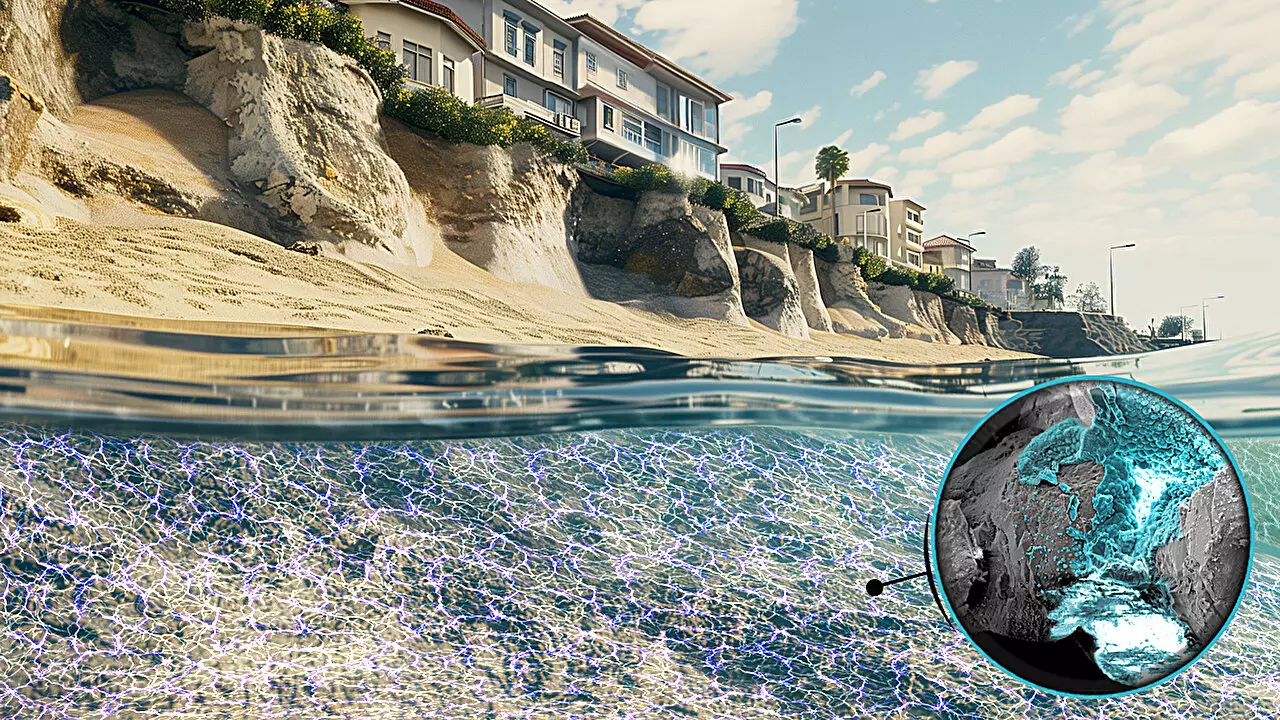As climate change accelerates and sea levels continue to rise, coastal communities worldwide face an increasing threat of erosion. This pressing issue, affecting over 40% of the global population, requires innovative solutions that are not only effective but also sustainable and cost-efficient. Recent research conducted by a team at Northwestern University highlights an intriguing method that utilizes mild electrical currents to strengthen coastlines. By drawing inspiration from marine organisms like clams and mussels, researchers may have unearthed a groundbreaking approach that addresses the critical problem of shoreline erosion.
In their pioneering study titled “Electrodeposition of calcareous cement from seawater in marine silica sands,” researchers sought to replicate the natural processes used by shellfish to build their shells. These organisms adeptly utilize dissolved minerals found in seawater to create sturdy exoskeletons. The Northwestern team, led by Alessandro Rotta Loria, adopted a similar approach but substituted the metabolic energy of mollusks with an electric stimulus.
By applying a mild electric current of 2 to 4 volts, the researchers triggered chemical reactions in the seawater, which caused the dissolved ions and minerals to crystallize into solid formations. Minerals such as calcium carbonate and magnesium hydroxide, known for their strength and adhesive properties, began to bind sand particles together. In laboratory experiments, the sand transformed into a rock-like solid, providing a potential solution to the ongoing battle against coastal erosion.
Historically, strategies for beach protection have largely relied on constructing barriers like sea walls or injecting cement into the sandy substrate. While these methods aim to shield coastlines from erosion, they are often prohibitively expensive and lack durability. Sea walls, for instance, can suffer from erosion themselves, leading to an eventual collapse as the substrate beneath them disintegrates.
Moreover, the use of traditional cement can have several environmental repercussions, adding chemicals that are not sustainably sourced. These methods frequently demand high energy inputs and complex infrastructure that are not feasible in many coastal areas, making them less attractive solutions for communities already grappling with the financial impact of erosion.
The Northwestern research team’s electric cementing process presents several key advantages over conventional methods. First and foremost, it offers a significantly reduced cost—estimated at just $3 to $6 per cubic meter for electrically cemented ground compared to traditional methods that can soar to $70 per cubic meter. This affordability makes it an appealing option for communities with limited budgets.
Additionally, the technique operates with mild electrical currents, thus posing minimal risk to marine life. Previous studies utilizing similar electrical methods for strengthening subaqueous structures have demonstrated no harmful effects on local ecosystems. The process is also reversible; by simply switching the polarity of the electrodes, researchers can dissolve the cemented minerals, allowing for adaptive management of the shorelines if necessary.
Rotta Loria’s team anticipates that the treated sand, which takes on a solid form reminiscent of concrete, will remain robust for years, potentially shielding coasts from erosion for decades. The structure created through this process can withstand various environmental stressors, making it a valuable asset in an era defined by climatic uncertainty.
The implications for this technology extend beyond just shoreline reinforcement. The electrical cementing process could also heal structural cracks in existing concrete infrastructures, such as piers and buildings that are increasingly vulnerable to the effects of climate change. This ability to repair rather than rebuild could prove invaluable for municipalities looking to extend the lifespan of their coastal assets.
As the impacts of climate change continue to threaten coastal environments globally, exploring innovative and sustainable solutions becomes imperative. The findings from Northwestern University present a hopeful outlook: a method that could redefine how we approach the maintenance and protection of coastlines. With further testing planned outside the laboratory, this electric cementing process could soon transition from theory into practice, aiding communities in the fight against rising seas and intense weather events. The journey ahead may be challenging, but the potential rewards—preserving ecosystems, protecting communities, and ultimately reshaping coastal management—envision a brighter, more resilient future.

